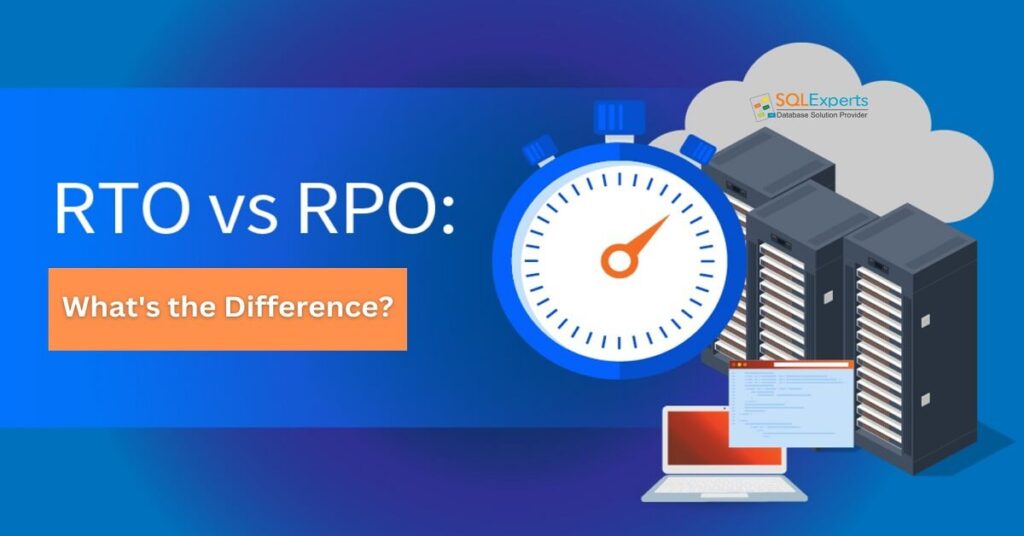Data fuels companies to the point where – in this age of technology, training on data protection strategies is imperative for the belief in the continuity of any business.
There comes a time when things go wrong – hardware failure, cyber intrusion, or even a natural calamity and an organization has to be able to recover as fast as possible with the least amount of data loss possible.
There are two important disaster recovery planning metrics: Recovery Point Objective (RPO) and Recovery Time Objective (RTO).
The present blog discusses RPO and What Is The Purpose Of RTO, significance, and position within the greater data protection strategy.
What Is Recovery Point Objective (RPO)?
Recovery point objective (RPO) is defined as one of the most important dimensions of disaster recovery and data protection.
It is the determined maximum duration of data loss due to the occurrence of a disaster.
RPO describes the time frame within which data is available for potential restoration following an unforeseen event.
In simpler terms, RPO specifies the point in time to which data needs to be restored after a data loss event to minimize business impact.
Recovery point objective rpo example, when an organization states that its RPO is 4 hours, this means that, in the most extreme case, unduplicated data for no more than 4 hours’ duration will be lost.
Importance Of RPO Recovery Point Objective
RPO is important in the development of a business continuity plan because it gives direction on how often backups and data syncing should be carried out.
It allows organizations to determine the negative impact of data loss and draw viable backup plans that restore data within the stated limits.
A lower RPO indicates that backups are taken at shorter intervals, hence a less risk of losing data, whereas a higher RPO indicates that backups can be taken after longer intervals but there is more risk of losing data in the event of a catastrophe.
In this way, RPO helps cuts data protection costs to what the company deems as the fit level of risk.
Recovery Point Objective Examples
For instance, let us take the case of a financial services company in the business of processing transactions round the clock.
If this organization has an RPO of 30 minutes, it implies that during a mapping data failure or loss of data, the company must have their backup data of not more than 30 minutes.
This guarantee serves that, systems which they restored will only lose 30 minutes’ worth of transactions at the most.
RPOs that are shorter mean that for the organization, it becomes more important or most ideal that data backup be done continuously and automatically without any manual intervention.
These examples illustrate how different industries set RPOs based on their specific needs and risks associated with data loss.
RPO vs. RTO: Key Differences
RPO and RTO are often confused but have distinct meanings. RPO, or Recovery Point Objective, focuses on data loss. RTO, or Recovery Time Objective, emphasizes downtime.
Knowing the differences between RTO and RPO helps businesses prepare effectively.
Here, we’ll break down RPO and RTO. We’ll highlight their importance and provide insights for better planning.
Let’s dive into these key concepts and improve your disaster recovery strategy.
- Recovery Point Objective (RPO) emphasizes on the loss tolerance of the data and stipulates the frequency in which data backups or syncs have to be undertaken.
- Recovery Time Objective (RTO) Facets concentrates on the aspects of system recovery time objectives and the operations restoration time after a disruption has occurred. It is a measure of how fast an organization needs to come online to avoid excessive operational downtimes. Knowing what RPO and RTO stand for and their respective differences allows the businesses to categorize their recovery strategies in terms of data availability and the rate of recovery .
Relationship between RPO and RTO:
- A lower RPO generally requires a lower RTO to minimize the impact of data loss.
- However, a lower RTO may require additional resources and redundancy, which can increase costs.
Example:
- RPO: 2 hours (Can tolerate 2 hours of data loss)
- RTO: 4 hours (Must restore operations within 4 hours)
In this scenario, the organization can afford to lose 2 hours of data, but it must be able to restore operations within 4 hours.
This means that backups must be frequent enough to capture data every 2 hours or less, and the disaster recovery plan must include sufficient resources to restore operations within the specified timeframe.
How Does RPO Work?
RPO exists to establish a manner appropriate of backing up and replicating data in order to protect it within the obtained data protection level targeted by the organization.
In this case the organization has to evaluate different types of data and their importance so as to determine the amount of data loss that can be tolerated.
For instance, some organizations have mission-critical databases which routinely would not probably expect an RPO larger than a few minutes and therefore requires that data be transferred to a ‘hot’ standby reduces in real time.
Whereas, less critical information such as archived correspondence, may take two RPOs of 24 hours since a back up is done on a daily basis.
The objective is to schedule and use backup processes (ex: continuous replication, hourly backup, etc.) that will allow restoring data to a point, which with respect to business requirements is tolerable.
What Does RPO Mean in Cloud Data Protection?
In cloud contexts, the recovery point objective (RPO) is critical to data propagation techniques and backup strategies.
Public cloud services from AWS, Microsoft Azure and Google Cloud Services tend to have embedded functionality of setting RPO threshold targets, thus easing the burden of replication of data across region or availability zones for the organization.
Take for instance, the use of cloud databases such as Amazon RDS and Microsoft SQL Azure Database, where there are features such as automatic backups and point in time restoration so that organizations can set their RPO expectations without having to manually manage the backups.
The architecture of cloud service delivery also means that lower RPOs can be achieved easily without investing heavily on premises and this is helpful to most small and medium enterprises.
What Is RPO Used For? Advantages
RPO (Recovery Point Objective) provides several advantages for organizations in their disaster recovery planning:
- Minimizes Data Loss: There are measures open to businesses against potential data loss during a disaster by setting an appropriate RPO where crucial data will remain present.
- Aligns with Business Needs: RPO enables companies to customize their data backup principles based on the severity of various data sets, thereby guaranteeing the appropriate level of data protection for different data types.
- Supports Compliance Requirements: In sectors where there is a data retention regime which is strictly adhered to, the approach of configuring a low Recovery Point Objective (RPO) also helps in meeting the compliance requirements for regulations such as the General Data Protection Regulation (GDPR) or the Health Insurance Portability and Accountability Act (HIPAA).
- Cost Optimization: RPO assists organizations in managing the economics of ongoing data replication and data loss tolerable, thus enhancing the cost effective disaster recovery planning.
- Improves Business Continuity: A clearly stated recovery point objective helps to recover business operations almost instantaneously thereby maintaining customer loyalty and revenue generation.
In summary, RPO is a valuable tool for organizations to quantify data loss tolerance, improve business continuity, optimize backup strategies, ensure regulatory compliance, manage risks, and make informed decisions about data protection investments.
Why RPO Is Important?
In sectors like finance, health care or e-commerce, where operational disruptions can lead to catastrophic consequences with even a small window of data loss, RPO proves to be significant in Continuous Operations (CO) and customer confidence.
It establishes a standard threshold within which a data backup should be performed, and assists the IT department in formulating a strategy for recovery of data that meets business goals.
RPO allows businesses to have a plan in case of a calamity by establishing how much data lost is acceptable to the business as well as makes sure that data protection strategies are in concord with and risks that the business is willing to face.
How is RPO calculated?
In order to calculate the RPO, there is a need to understand how data is utilized, business processes implemented, and the importance of the information in detail.
Below are the steps to establish suitable Recovery Point Objective:
- Assess Business Needs: Comprehend the weight of various data sets as well as operations. Determine which data is the most critical for the continuing business processes.
- Analyze Data Volumes: Quantify the volume of data created within a stipulated period, for instance, on an hourly or daily basis. This assists in appreciating the extent of the potential loss impact.
- Determine Downtime Impact: Assess the impact in financial terms, operational terms and in terms of reputation of losing data depending on the length of losing data.
- Set Data Loss Tolerance: From this analysis, it can be determined how much data loss is tolerable for each system, or each data type.
- Align with Backup Frequency: Opt for a backup or replication mechanism that provides the possibility to restore data to a predefined RPO. This may include but is not limited to, continuous backup, hourly snapshots, and more.
Recovery Point Objective Strategies and Best Practices
In designing a workable RPO strategy, one must possess knowledge of the best ass backup tools and methods.
Critical data can be real-time replicated to secondary servers, for example, while non-critical data may simply be backed up every twenty-four hours.
Backups should not only be made but they should be tested with a restoration at a particular point of time to ensure that the data can be taken back to that point.
Other recommended procedures are using a storage solution for cloud backup purposes, employing smart switches to backup data and all data backups stored offsite in a secure location to prevent any natural calamity from destroying the data.
Recovery Point Objective in Disaster Recovery Planning
In a well-drafted disaster recovery strategy, RPO goes hand in hand with RTO to formulate a policy for ensuring continuity of operations.
It helps in understanding the frequency of the data backups to be performed and what kind of backup storage will be required i.e. local, off-site or cloud storage.
Otherwise businesses will not be able to incorporate solutions to minimize the effects of data loss and will find it difficult to resume business operations in a short period of time.
Common Recovery Point Objective (RPO) Challenges and Solutions
Achieving the RPO an organization targets often proves a daunting task. This may ** include ** the frequent backup of data for protection ‘every hour’ or the evolution of technology which allows replication of information in real time.
Solutions Focused on the problem Changing the outlook of data according to its importance, Installing incremental backups in order to save space or even resorting to the cloud for cheaper and wider free storage.
It can be noted, however, that automation tools may be useful in ensuring that the backups are done on the stipulated time, therefore, help in eliminating the chance of human error.
Case Studies
- Case Study 1: A banking organization that employed a recovery point objective of 5 minutes with active data mirroring for minimizing losses in transactions.
- Case Study 2: A healthcare system that utilized cloud storage for non-critical information and in-house facilities for continuous patient record updates to optimize RPO and backup expenditures.
- Case Study 3: A certain e-commerce organization, in peaks season, ensured protection of customer orders by implementing an RPO of 1 hour as a result rendered cut down data loss.
Conclusion
An integral part of all disaster recovery and data protection plans comes the Recovery Point Objective (RPO).
By knowing and articulating the threshold for acceptable data loss, a company would not only be ready for any data loss but also assure its clients’ trust and the business operations seamless continuity.
The right approach towards RPO allows one to effortlessly deal with data protection while remaining productive even in the treated uncertain conditions.



